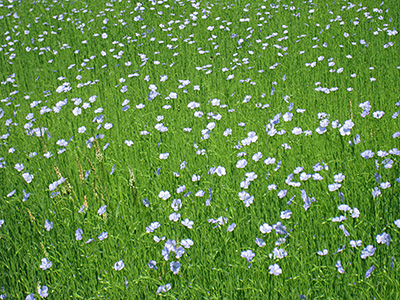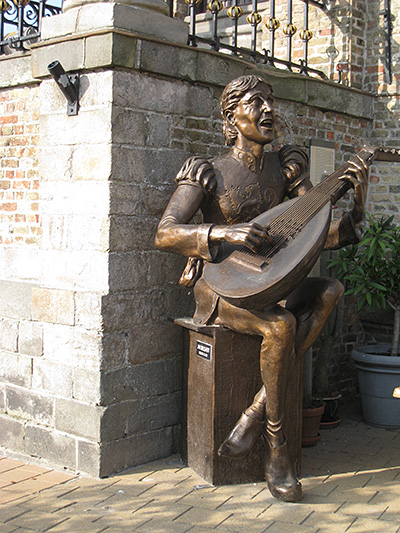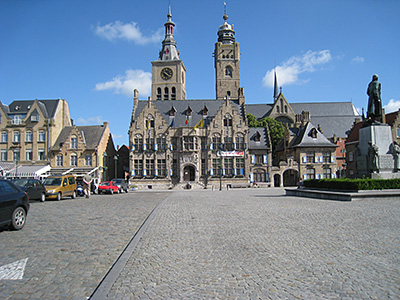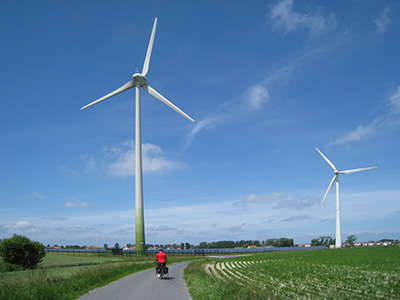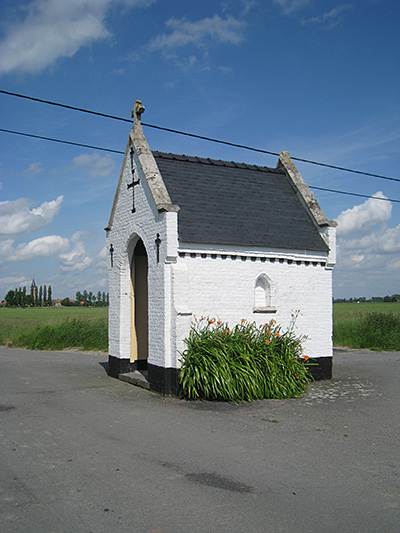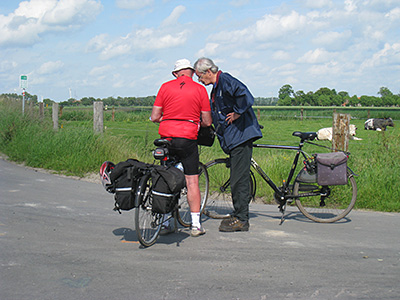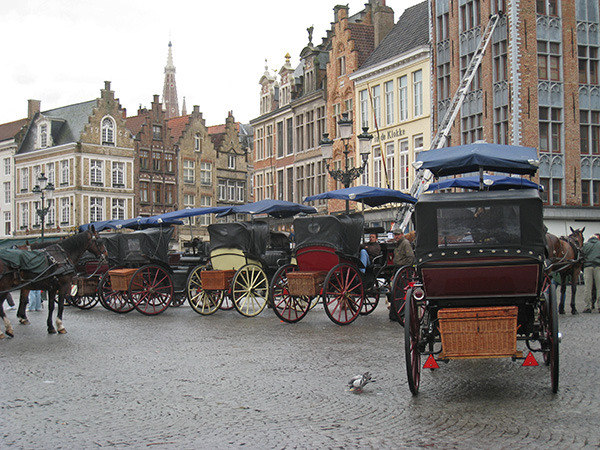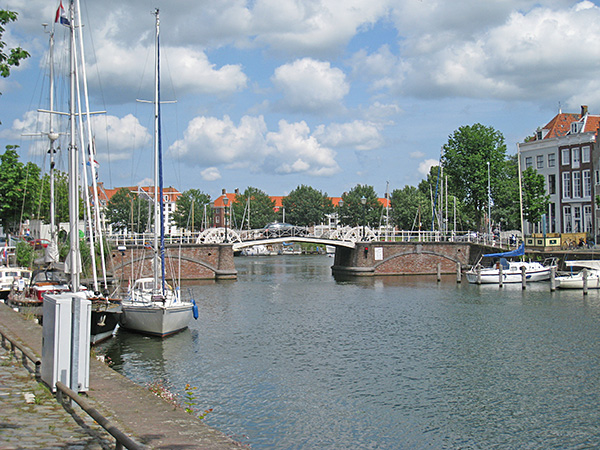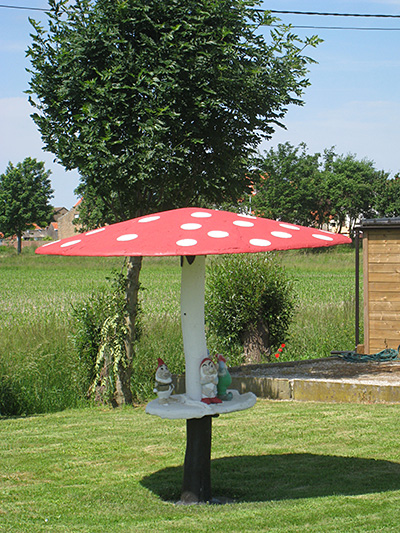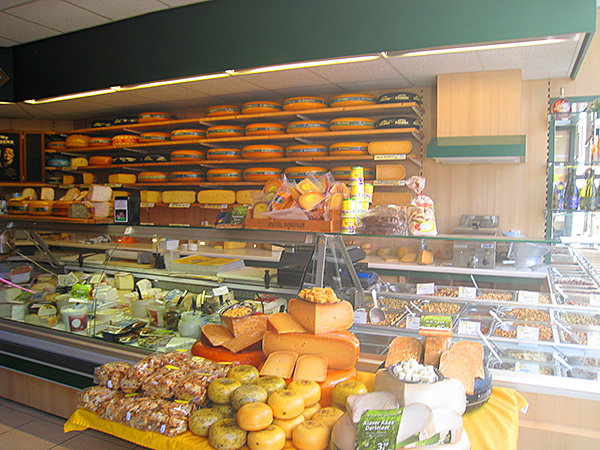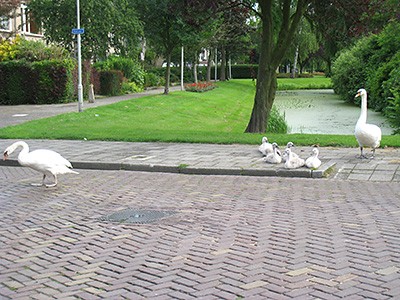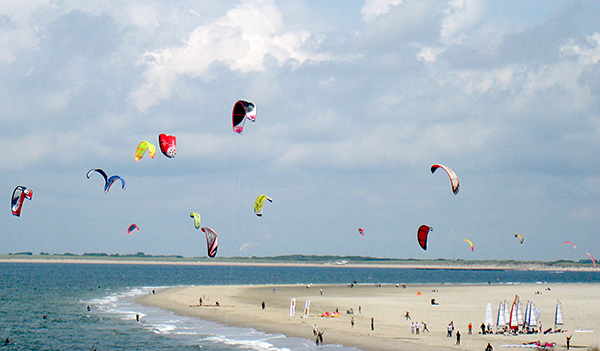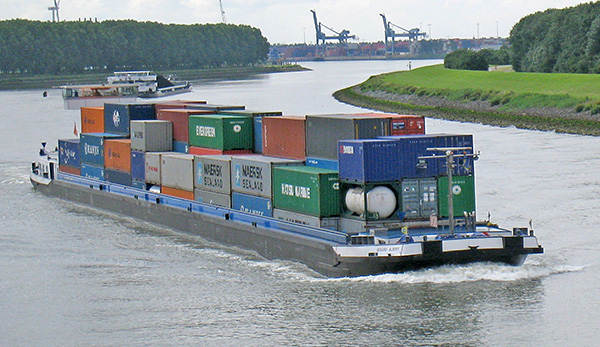
Trips June 2000, June 2008
Bicycle the North Sea Cycle Route, LF1, in France, Belgium, and the Netherlands
Cycle 450 kilometers (270 miles) along quiet roads, dikes and bike paths, often in view of the North Sea, on your self-organized biking tour.
Bike Rating: Excellent
Nature of the North Sea Bicycle Route: The North Sea Route traverses lands along and near the North Sea that are seldom visited by English and American tourists (except for the town of Bruges and the WWI and WWII battle zones). The route begins in Boulogne-sur-Mer — an interesting city on the English Channel about 45 miles (75 kilometers) south of the North Sea, and then passes through northernmost France, Belgian Flanders, Zeeland (i.e., Sea-land) province of the Netherlands, and Holland. It totals in length almost 300 miles (500 kilometers). The ending of this route occurs in the northernmost island of Holland, but nothing stops the cyclist from continuing on intoGermany, Denmark and Norway along the North Sea, and then, after a ferry ride, continues down through Scotland and England to the coast opposite Boulogne-sue-Mer, a 3,600 mile (6,000 kilometer) circuit that goes by the name North Sea Cycle Route.
I give this route a high rating because you bicycle in several types of terrain; because you visit several patterns of habitation and agriculture in three different nations; because you peddle by or through beautiful sand dunes and beaches, and across broad estuaries on miles-long mechanical dikes***; because you ride some ferries; and because you visit numerous very pretty and interesting towns and cities, of which two are astonishingly world class: Bruges (Brugge), Belgium***, and (after the official Route is over) Amsterdam***.
Below: North Sea Beach in Zeeland.
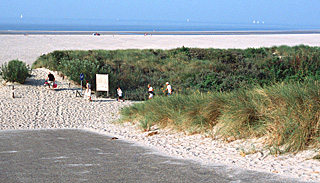 Except
for the centers of the more importat towns, there is a certain starkness to most of
this voyage: a duller light, monotonal greens, browns and beiges, simple buildings,
few signs of wealth or importance. It is a far cry from the brightness of Provence or the showiness
of the Danube or Alsace Wine Route. You feel the dominance of the cold North
Sea, of the winds, of the weather. Yet, I went back to ride this route only a few years after my original trip. There is
something compelling in the forces of nature, intersperced with occasional artistic highs.
Except
for the centers of the more importat towns, there is a certain starkness to most of
this voyage: a duller light, monotonal greens, browns and beiges, simple buildings,
few signs of wealth or importance. It is a far cry from the brightness of Provence or the showiness
of the Danube or Alsace Wine Route. You feel the dominance of the cold North
Sea, of the winds, of the weather. Yet, I went back to ride this route only a few years after my original trip. There is
something compelling in the forces of nature, intersperced with occasional artistic highs.
Difficulty:
This trip can be relatively easy or difficult, depending upon the weather. If you are an easy-going biker, I recommend this trip only if you are allowing extra days to wait out the winds and the weather, or to ride short segments. You can run into fierce winds against you in the flatlands or along the North Sea with little, if any, protection against them. In discussing the wind, one Belgian bicycle shop owner put it this way: Tthe winds are our mountains and they make cycling interesting". However, unlike mountains where you always ride both up and down, your trip conveivably could always be against the wind. The prevailing winds , on the other hand, are usually behind or to the side, so if you ride short stages or wait it out, the wind should shift in your favor.
On the first trip I made—hard but enjoyable—I fought a 20 mph headwind for several days in a row (but was lucky to have no rain). On the second trip, in contrast, the winds were mainly lateral or even from behind, the sky was sunny, and the cycling was relatively easy. The second trip actually was a substitution for a planned trip in the south of France, which had unexpectly stormy weather. I knew that the long-range forecast for Northern France, Belgium and the Netherlands was for sunny, mild weather. Again, check the forecast before you come, or allow extra days.
As to the difficulty of the terrain, at the beginning of the ride, near Boulogne, you will experience rolling terrain with a couple of climbs -- nothing too difficult. After the first 70 kilometers, you approach and enter Flanders—the "flat country" immortalized by the song of Jacques Brel. The terrain becomes, in fact, nearly flat, until you reach the small dunes along the Holland shore.
Traffic and Pavement Quality:
The North Sea Route rarely encounters any traffic at all. The exceptions would be in Boulogne-sur-Mer, where you can walk your bike on sidewalks, in Bruges, where hundreds of bicycles mingle with the relatively light traffic, and in bike lanes along busy streets in The Hague (where there are sidewalks as an alternative).
The road surfaces you will ride on vary considerably: In France there are two Departments along the route, and the first, Pas-de-Calais has very uneven, even bumpy, back roads that will slow you down by a third or more. The other Department, Nord, has much better roads, but will still slow your riding speed by perhaps 15%. In Belgium, by and large, the roads and bike paths are smooth and fast going. Ridding in the Neatherlands is mainly on smooth roads or on bike paths. The bike paths vary considerably, from very smooth high speed ones, to bumpy slow ones, to even slower ones using paving stones of various sizes and evenness amongst the Holland dunes. You should not plan to cover the same ground in France, or along the Holland dunes, that you would on a smooth highway. In order to avoid using wider tires or save time, you might want to bike on the roads alongside the dunes. However, with 700 28C tires and a thirty pound load, and only occasionally walking my bicycle, I was able to utilize the dune bike paths.
Finding Your Way:
Typically, on the North Sea Cycle Route you do not follow your own trip routing, but rather a waymarked or signposted route, the LF1, the "Route de la Mer du Nord" in French or "Nordzee Fiets Route" in Flemish, that has been laid out by local organizations, working with regional authorities to create a seamless whole. To the author, the guiding principle of the waymarking seems to have been to avoid traffic while visiting interesting sights of nature. The route normally skirts towns, and if you enjoy visiting towns, you should by all means deviate occasionally from the officially marked route. For the author these deviations really improved the pleasure of the ride. Towns especially worth visiting are cited in the trip details below.
All turns on the route are supposed to be marked by signposts that bear the name "LF1" or "Noordzee Route" or "Nordzee Fietsroute" (in Flemish) or "Route de la Mer du Nord"( in French). Sometimes the "LF" is followed by an "a", which means the south or westwards direction of the route, or a "b", which means the north or eastwards direction. The author has always ridden, and describes the route from southwest to northeast, so if you get lost, and you come across a sign, one should ride in the LF1b direction.
 In reality,
the markings of the North Sea Route are spotty in France and in
southern Belgium — and occasionally erroneous. It is helpful, after a turn or if you are doubtful, to look for the sign for the other direction, which will confirm you are on the right route.
In reality,
the markings of the North Sea Route are spotty in France and in
southern Belgium — and occasionally erroneous. It is helpful, after a turn or if you are doubtful, to look for the sign for the other direction, which will confirm you are on the right route.
If you rely solely upon the signposts in France and southern Belgium, you will probably lose the correct route and become hopelessly lost. Although, the markings in the Netherlands are good, when coming from the south as per this itinerary, you can very easily go astray in the large city of The Hague (Den Haag). (The author was twice lost there.)
For these reasons it is advisable to have a guide book with maps and the map packet described below , even if, like the author, you can not read the text.
The directions that I have provided, below, will save you much grief and some long, unrewarding detours, and can also direct you to some tourist sights that are not on the official route. I strongly suggest that you first transpose these to your maps, if you have some, to prime you what to look out for.
You will not be able to purchase a guidebook in France! The French guidebook is out of date, and was never available in stores. Very few, if any French bikers ride this route. Most cyclists are Dutch, and they usually begin from home and ride southwest to the sunnier climes of northern France...or beyond. For information on obtaining maps, see the section on books and maps below.
Another helpful guide to bicycle navigation are signs to various towns, in both Belgium and the Netherlands, which indicate good bicycle routhes, often faster than the ones of the LF1.
Particularly helpful is a new system, not yet fully reflected on many maps, of numbered points at intersections along bike routes, such as, for example, 51. From each numbered point, signposts indicate the direction to other nearby numbered points (for example 3,52, 46). On many occasions, along the bike route, arrows with numbers show the way to the next numbered point. For example, using anAmsterdam area cycle map purchased in a local bookshop, I followed with relative ease a self-created bicycle itinerary from the North Sea coast near Nordweg to central Amsterdam, a distance of about 50 kilometers, cycling from signpost to signpost..
Language:
Many people in France and most people in Belgiium and the Neatherlands will speak sufficient English to be helpful.
Lodging:
Hotels and Guest Rooms are not plentiful along the route, except in Bruges, and even in Bruges on weekends and in July and August hotels can book up. The detailed text below suggests some possible lodgings. When possible, it would be helpful to book a day or two ahead or more. There are some offical camp sites, and many suitable places to pitch a tent in an emergency.
The Eight-Country North Sea Cycle Route:
There is another route called the North Sea Cycle Route that partly overlaps part of this itinerary. This other route starts in Belgium and continues through the Netherlands, Germany, Denmark, Norway, Sweden, Scotland and England. It is 3,600 miles (6,000 kilometers) long. For plentiful information on this other route, visit the site http://www.northsea-cycle.com. This URL will bring up the interactive map of the route: http://nscr.avinet.no/default.aspx?gui=1&lang=1. This route joins up with the Itinerary of the LF1 just after the Netherlands border. The initial part of the route in Belgium bypasses Bruges and Sluis, which in my opinion should not be missed, and does not visit France or the interior of Belgium at all.
Before you decide to undertake the totality of the long "Cycle" route — even over several years — consider the possible downsides of cold weather, of frequent wind and rain, and of sparse habitation. On a Germany-Denmark cycling trip in 2011 that started in Hamburg, we followed the North Sea Cycle Route from Hamburg into Denmark. We faced, unfortunately, constant gale force head winds as we emerged from the Elbe River vallely to the dikes along the North Sea. In discussions with a local restaurant owner, we learned that these winds are omnipresent. "Gale force winds are nothing here." he said,. "In winter they blow constantly with hurricane force." We ended up taking the train to an inland town, and bicycled away from the coast.
Below: The blockhause of Eperlecques was built
by the Nazis
to launch V2 rockets against England.

Below: Restaurants in
ancient buildings
line one side of the main square in Bruges.
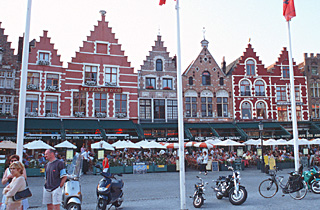
When To Go:
June, July, August or September. Midsummer gives the best chance for warm, dry days, but seaside and vacation hotels space is tight.
Below: In the old town of Boulogne-sur-Mer.
 Points of particular interest:
Points of particular interest:
At the start of the trip, the old town** of Boulogne-sur-Mer, with its rampart views, basilica, and château, are well worth an hour-long visit. A short detour from the main route, just north of Boulogne is the very pretty seaside village of Wilmereux;a visit would add no more than an extra 2 kilometers to your trip. A charming countryside of farms on rolling hills follows. The Blockhaus of Eperlecques, a site from which the Nazis launched V2 rockets against England, is interesting, and displays a collection of WWII weapons. The nearby forest along the route contains a high hill with a viewpoint.
The first 60 miles (100 kilometers) of flat riding in French and Belgian Flanders are made interesting by the presence of a few pretty villages and the Yser (in France) = Ijzer (in the Netherlands) river-canal. The influence of nationality on both housing and farmland is remarkable, as one crosses the frontier into Belgium (and again, into the Netherlands). There are many minor points of interest to stop and visit, if you care to take the time. The author recomends a detour off route of less than 2 km to the Belgian town of Lo (near Pollinkhove), and of a few hundred meters into Diksmuide..
Below: On the main square, the city hall of Bruges (Brugge).
 You
soon arrive at the sensational little city of Bruges*** (Brugge
in Flemish or Dutch), which absolutely demands a two nights' stay. Almost all Bruges building exteriors remain as they were in the
15th century. Too many fine sights exist in Bruges to list here;
obtain a guidebook, or tourist information from the Bruges tourist
office, or visit the excellent Internet site: http://www.brugge.be.
In Bruges, do take walking tours, leaving your bike locked in a secure place at your
hotel. Because of tremendous demand, somehotel rates can be on the expensive
side, and on weekends space is almost not available, so try to arrive
on a week day or plan weeks ahead.
You
soon arrive at the sensational little city of Bruges*** (Brugge
in Flemish or Dutch), which absolutely demands a two nights' stay. Almost all Bruges building exteriors remain as they were in the
15th century. Too many fine sights exist in Bruges to list here;
obtain a guidebook, or tourist information from the Bruges tourist
office, or visit the excellent Internet site: http://www.brugge.be.
In Bruges, do take walking tours, leaving your bike locked in a secure place at your
hotel. Because of tremendous demand, somehotel rates can be on the expensive
side, and on weekends space is almost not available, so try to arrive
on a week day or plan weeks ahead.
Below: Cyclists wait to board the Westerschelde ferry.
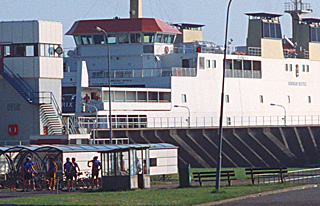 After
Bruges*** comes the Netherlands, and your first encounter with the
coastal dunes. It is worth going into Sluis, as it is very charming. You will take a short ferry ride across the Westerschelde
estuary. Central Middelburg merits a visit; then cross the rest of the peninsula, see perhaps the prettiest beaches of the entire trip, and pass onto the first of three
long dikes in the province of Zeeland. These are very impressive
dikes**, 6, 3, and 2 miles long; the first one, in two sections, has a multitude of
plates that automatically descend during storms to close off inland
waters from the North Sea. In Zeeland, the land is completely flat
and without many trees. You are completely exposed to the elements—don't
try to cross the Zeeland penninsulas during periods of high wind
and rain. After entering the province of South Holland you cross
the Nieuve Maas River by ferry near Rotterdam**, to which you may
make a side trip. Here you pass through a highly urban and industrialized
landscape, but only for a few miles.
After
Bruges*** comes the Netherlands, and your first encounter with the
coastal dunes. It is worth going into Sluis, as it is very charming. You will take a short ferry ride across the Westerschelde
estuary. Central Middelburg merits a visit; then cross the rest of the peninsula, see perhaps the prettiest beaches of the entire trip, and pass onto the first of three
long dikes in the province of Zeeland. These are very impressive
dikes**, 6, 3, and 2 miles long; the first one, in two sections, has a multitude of
plates that automatically descend during storms to close off inland
waters from the North Sea. In Zeeland, the land is completely flat
and without many trees. You are completely exposed to the elements—don't
try to cross the Zeeland penninsulas during periods of high wind
and rain. After entering the province of South Holland you cross
the Nieuve Maas River by ferry near Rotterdam**, to which you may
make a side trip. Here you pass through a highly urban and industrialized
landscape, but only for a few miles.
The last 90 miles (150 kilometers) of the Route — if you choose to ride all of it — follows bike paths and some minor roads next to, or nearby the North Sea, mainly along or through sand dunes, but also through some towns. You pass through parts of Den Haag** (The Hague), some seaside resourts and then Haarlem**. The Route ends in Den Helder at the very northwest tip of Holland.
Below: From the dike, mechanically
operated
plates descend during storms to close the
estuary off from the North Sea.
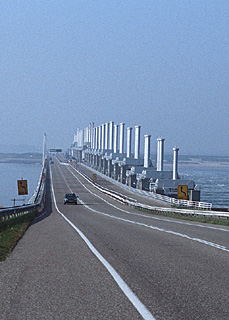 From
Den Helder and from other northern points, you may attain Amsterdam*** by train or by a ride back to the south of some 50 miles (90 kilometers), or via a long trip around the Ijselmeer (see trip discussion on this site)..
You may also continue your trip to the island of Texel, and/or eastward
to the German border on the LF10 route, and onwards through Germany, Denmark, and Norway..
From
Den Helder and from other northern points, you may attain Amsterdam*** by train or by a ride back to the south of some 50 miles (90 kilometers), or via a long trip around the Ijselmeer (see trip discussion on this site)..
You may also continue your trip to the island of Texel, and/or eastward
to the German border on the LF10 route, and onwards through Germany, Denmark, and Norway..
From the Holland shore, shortcuts are possible: For example, from Zandvoort, near Harlem**, you may ride — as did the author — to Amsterdam***, entirely by bike path, in about 30 kilometers. This shortens the total trip riding distance to about 250 miles (420) kilometers.
How to Bike the North Sea Route: Organize the trip yourself, ideally with a few days flexibility to allow for unfavorable weather. The author has not located any company offering
this tour, nor seen commercial groups riding.
.
Organizing the North Sea Bicycle Trip Yourself:To print itinerary, select the text below, right click, and choose 'print selection'. Distance and Time: 250 to 280 miles (420 to 470 kilometers), 6 to 10 days plus rain
days. Trip can be extended on LF10 to the German border and beyond,
or back to Amsterdam via inland roads or via the Ijsselmeer. Starting and ending points: Boulogne-sur-Mer, France, and Den Helder (or Amsterdam), Netherlands, all accessible from Paris by trains carrying assembled bicycles. As of this writing there were several morning trains carrying bicycles from Paris, taking under 3 hours. There seems to be only one option for carrying an assembled bicycle between Amsterdam and Paris, which requires a 14 hour trip with two connections, at night, via Germany. A bike transporting bag will allow the Amsterdam -Paris trip to be done in 4 hours on a TGV. See the page of this site on "trains and bicycles" for details on bikebags and on researching and reserving trains carrying bicycles. For cyclists coming from Belgium, Holland, or Germany, from the city of Lille it is possible, several times a day (either directly or through Calais) to bring a bicycle with you to Boulogne-sur-Mer. Lille has two railroad stations, about 500 yards (meters) apart. (From Calais it is easily possible to join up with the LF-1 Route in Watten by following the Canal de Calais. However, the author believes this would be boring, and suggests, rather, a quick train ride to Boulogne-sur-Mer). Ferry Service operates from Folkestone, England to Boulogne. There is also return ferry service from Amsterdam to Newcastle and from Hoek van Holland to Harwich. These can be combined with train service. For those originating in Amsterdam, a train trip (requiring use of a bikebag) to Boulogne-sur-Mer can be accomplished in 5 or 6 hours. One day SUV car rentals can often be economical for two or more persons. Rates vary considerably from day to day. For all types of transportation, rates are usually considerably lower the further ahead you book. Which direction to ride?: If you ride starting from Boulogne, France, as suggested here, the morning sun will generally be off to your right, particularly once you reach Belgium,and midday sun, somewhat low in the northern Netherlands sky, will be generally at your back. In the other direction, the midday and afternoon sun will tend to be in your eyes. Since riding into the sun is both hard on the eyes and reduces the clarity of views, this is probably reason enough -- all else equal -- to ride from the southwest to the northeast. Wind: The author's limited research on the Internet ( one year'data), backed up by the comments of one Belgian drawbridge operator, suggests that, for the months of June, July, August and September, days of wind coming from the west (i.e., w, nw or sw) outnumber those from the east by a ratio of about 4 to 1. (That is, there are 66 days of wind from the west, 18 from the east, and 36 days where there is either no wind or in is from the due north or south.) In June and July, the wind most often had a northern component (21 days from the north, 12 from the south and 28 days where there was no wind or it was from the due east or west). In August an equal number of days had a northern and southern component to the wind. In September the wind blew from a southerly direction 75% of the time. If the Internet data is typical, it is usually advantageous throughout the trip to be biking from Boulogne to Den Helder, in the sense described below. In the more westerly parts of your trip you probably will be lucky enough to have the wind partly at your back; in the more northerly parts, in June and July ,it will probaby be at your quarter and in August and September also at your back.. This is, in fact, exactly what happened on the authors second trip in June, while in the first trip he was unlucky to have the winds against him all the way. In summary, unless you have some other reason for beginning in Holland, it is probably best to ride from Boulogne (as decribed here). Guide books and Maps: The author strongly recommends that you obtain and carry with you the guidebooklet : DE LF1 - Noordzeeroute (weighing 6 ounces - 146 grams). This book is in Dutch (an outdated edition in English and Frenchis no longer available). It covers the route only from Boulogne-sur-Mer to The Hague in South Holland. Published in 2006, it describes the signposting for the route (LF1), the general nature of the terrain to be traversed, and many of the minor sights to be passed (but not the major ones such as Boulogne-sur-Mer or Bruges). It contains 1:130,000 maps (from Boulogne to Bruges -- 1:150,000 from Bruges to The Hague) with the LF1 route marked (but the official route has been moved since in several places), and lists the phone numbers of some but by no means all accommodations. The maps show the distance from the south end of the route every 10 kilometers, as well as, in Holland, the marker numbers (such as 23689)of the ANWB biking signposts, and in Belgium the biking intersection point numbers (but not the ones recently introduced in the Netherlands). (This guidebook does not, however, provide detailed directions such as highway numbers or where to turn, and also its maps lack detail and highway numbers. There appear to be errors in a couple of spots. You might wish to add highway numbers to the guidebook maps from the description below.) Note: You will need to add an 03 in front of all French telephone numbers listed in the guidebooklet, if calling from France; or insert a 3 after the 0033 if calling from out of France. You can order the guidebook from Buijten & Schipperheijn, http://www.buijten.nl/uitgeverij_recreatief/, ISBN #90 5881 2367 (12.50 euros in 2012). To learn about shipping costs and to order, you may wish to email them at info@buijten.nl, or telephone (31)-20-524-1010. If you call, ask for somebody who speaks English. Assuming you will continue biking up the Netherlands coast from The Hague, you will additionally need the map packet and booklets named the Nederlandse Kustroute, published in 2007; this booklet covers the route from Sluis, on the Belgian border to the Netherlands border with Germany in the northeast. The author highly recommends this map packet from Bruges onward. The maps in this booklet are bigger (1:100,000) and clearer and more up to date than the previously mentioned booklet, but do not cover Belgium and France. It can be picked up for about 18 euros (2008), in-route in Bruges, for example at the bookstore (buchhandel) on the main market square, or also ordered from Buijten & Shipperheijn, (see paragraph above) for the same price. While not necessary, you may wish to have some larger maps to place your trip in perspective. Also, it will be extremely helpful, for France and in Belgiium as far as the Ijzer canal, to transfer highway numbers from maps onto the maps in your guide book, as they are absent. When you become lost, as you probably will several times, they can help you regain the route. Also, do print out the map for Bruges, as is explained below in the Itinerary. And print out maps of Boulogne-sur-Mer and Den Hague, Netherlands, and Amsterdam, perhaps from Google: http://maps.google.com. Bike Rental: Bring your bike. Lodging: Lodging is scarce along the route, and on sunny weekends it is especially scarce, so call ahead for reservations. The North Sea Guidebook has some lodging suggestions. Additionally, in each section of the Itinerary below, you will find suggested resources in France and Belgium. In the Netherlands, try the French version of the following page on the www.holland.com site (the page was not available in the British or American versions): http://www.holland.com Click on Hôtels or B&Bs or your other choice. On the new page click on Zélande or Holland-méridion. The list is only partial. Try also http://www.hotels.n; a city often gives the list of hotels nearby. And also Booking.com and Tripadvisor.com. Web searches on the words "hotel" and a specific city will frequently turn up other alternatives which cannot be booked indirectly. For Bruges, if you arrive without reservations and before 6pm, go to the Tourist Office near the train station. Security Tip: Do not leave your bike out unlocked, and if leaving your bike for more than a few minutes, lock it to a fixed object. Do not leave it out overnight, or at all in the center of major Netherlands cities. The author was told this emphaticaly on his first trip, and on his latest trip a clerk from a hotel near Amsterdam voluntarily stressed the importance of this to the author, stating that stealing bicycles was a city-wide pastime in Amsterdam and a common elsewhere. Your touring bicyce will be an especially juicy target. Helmets: Almost no Dutch or French riders wore helmets or hats along the itinerary of this trip. Potholes were virtually non-existent. I usually wore my helmet; but thought it safer to ride with a baseball cap in the mornings when heading into the rising sun. Please refer to my home page for links to pages costs, on touring styles, transportation, bike types, rentals, maps, information sources, traffic ratings, packing, and security and safety tips. Refer to this page for information on French pronunciation, French bicycle nomenclature, and French road signs. Star symbols in the text show ratings given by the Michelin green guide books, which the author likes and uses. Three stars mean worth a journey; two, worth a detour; and one, interesting.
|
